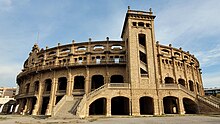Palma de Mallorca
This treaty was granted in exchange for a tax, respect for the social, economic, and political structures of the communities that subscribed to it, as well as the continuity of their religious beliefs.The city, being in Mallorca, constituted an enclave between western Christian and Islamic territories, and this attracted and encouraged increased levels of piracy in the surrounding waters.For wide sectors of the city's population, the sacking of ships (whether Muslim or Christian) which passed through Balearic waters was a source of riches over the next fifteen decades.As the city still occupied an eccentric position regarding the commerce network established by the Moors in the western Mediterranean, the enclave was not immediately incorporated into Al-Andalus.Provinces broke free from the central Cordoban administration and became effectively sovereign states — taifas — under the same governors that had been named by the last Umayyad Caliphs.The Banu Hud conquest of Dénia and its incorporation to the Eastern District of the taifa of Zaragoza meant the destruction of the legacy of Muyahid.The massive arrival of al-Andalus refugees contributed to reinforcing the positions of the last Almoravid legitimatists, the Banu Ganiya, who, conscious of their weakness in the Western Mediterranean context, started to get closer to the growing powers represented by Italian maritime republics.The Banu Ganiya, taking advantage of the great loss suffered by Abu Yuqub Yusuf in the Siege of Santarém, attacked Ifriqiya, where the Almohad dominion had not been consolidated yet, in the same year.[16] At the beginning of the 16th century, the Rebellion of the Brotherhoods (a peasant uprising against Charles V's administration) and the frequent attack of Turkish and Berber pirates caused a reduction of commercial activities and a huge investment in defensive structures.[19] The fall of Barcelona in 1714 meant the end of the War of the Spanish Succession and the defeat and destruction of the Crown of Aragon, and this was reflected in the Nueva Planta decrees, issued by Philip V of Spain in 1715.In the 18th century, Charles III of Spain removed interdiction of commerce with Spanish colonies in America and the port and commercial activity of the city grew once again.[citation needed] At the beginning of the 19th century, Palma became a refuge for many who had exiled themselves from the Napoleonic occupation of Catalonia and Valencia; during this period freedom flourished, until the absolutist restoration.[citation needed] With the establishment of the contemporary Spanish state administrative organization, Palma became the capital of the new Balearic Islands province in the 1833 territorial division of Spain.The French occupation of Algeria in the 19th century ended the fear of Maghrebi attacks in Majorca, which favoured the expansion of new maritime routes, and consequently, the economic growth of the city.[21] In the 21st century, urban redevelopment, by the so-called Pla Mirall (English "Mirror Plan"), had attracted groups of immigrant workers from outside the European Union, especially from Africa and South America.[24] The city also has several surrounding neighborhood communities including Establiments, Nord, Son Espanyol, Ces Cases Noves, and Sa Creu Vermella.To the north and west, the city borders the Serra de Tramuntana, the island's major mountain range, and a Unesco World Heritage site.The surrounding continental landmasses can warm up the offshore sea surface temperatures and as a result, the small confines of Mallorca are still able to build up and sustain heat despite being on an island.There are also train-themed playing structures, each one shaped like a train carriage and named after towns along the line of the Ferrocarril de Sóller, a railway dating back to 1911 which has its Palma Station right next to the park.The Parc de la Mar (Park of the Sea) lies just south, overlooked by the great building which sits above it on the city's stone foundations.The Banys Àrabs (Arab Baths, in English), one of the few remnants of Palma's Moorish past, are situated on Can Serra street, 7, near the Convent of the cathedral.The small two-roomed brick building that once housed the baths is of Byzantine origin, dating back to the 11th century[41] and possibly once part of the home of a Muslim nobleman.Palma's top team is CB Bahía San Agustín, which plays its home games at the 5,076 capacity Palau Municipal d'Esports Son Moix.















Palma (disambiguation)Capital citymunicipalityCathedralBellver CastleRailway of SóllerAutonomous communityBalearic IslandsProvinceIslandMallorcaComarcaJudicial districtMunicipal corporationDemonym(s)Time zoneCentral European TimeCentral European Summer TimePostal codeDialing codeBay of PalmaCabrera ArchipelagoTimeline of Palma de MallorcaTalaioticVandalfall of the Western Roman EmpireByzantine EmpireJames I of AragonTarraconensisPollentiaPhoenicianMediterranean SeaCarthageHispaniaSaguntumCarthago NovaWestern Roman EmpireMuslim conquestByzantineIslamicpiracypolitical structuresIfriqiyaMusa ibn NusayrUmayyad CaliphateAl-AndalusCharlemagneVikingCórdobaEmirate of CórdobaislandsUmayyadtaifasBerberSlavictaifa of DéniaAl-MansurMuyahid ibn Yusuf ibn AliDéniaSardiniaPisansGenoesemercantileItalian merchant republicsBanu Hudtaifa of ZaragozaMuslimsCatalansOccitansCrusadeRamon Berenguer III the Greatcount of BarcelonaProvenceCorsicaAlmoravidAlmoravid dynastyJames II of MajorcaXuetasMaghrebAlmohadItalian maritime republicsAbu Yuqub YusufSiege of SantarémreconqueredKingdom of MajorcaPerpignanPalace of AlmudainaCathedral of MajorcaCataloniaValenciaOttoman EmpireRoyal Palace of La AlmudainaAbraham CresquesJewishcartographerMajorcan cartographic schoolCatalan AtlasCharles VTurkishCatalina Tomascanonessmysticpatron saintsconventMary MagdalenePorto PíInquisitionxuetesendogamysyncretistXueta ChristianityWar of the Spanish SuccessionCrown of AragonNueva Planta decreesPhilip V of SpainCharles III of SpainSpanish colonies in AmericaNapoleonic occupation of Catalonia1833 territorial division of SpainAlgeria NureddunaEuropean UnionEstablimentsEuropean CommissionBordeauxCopenhagen
